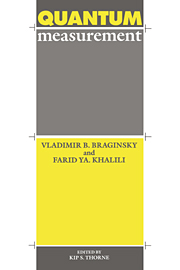Book contents
- Frontmatter
- Contents
- Dedication
- Editor's Foreword
- Notation
- Chapter I Historical introduction: photons and measurements using photons
- Chapter II The main principles of quantum mechanics
- Chapter III Indirect measurements
- Chapter IV Quantum nondemolition measurements
- Chapter V Linear measurements
- Chapter VI Continuous linear measurements
- Chapter VII Nonlinear systems for continuous measurements
- Chapter VIII Detection of classical forces
- Chapter IX Energetic quantum limitations
- Chapter X Devices for measuring small mechanical displacements
- Chapter XI Quantum nondemolition measurements of a resonator's energy
- Chapter XII Nonclassical states of electromagnetic waves as tools for quantum measurements
- Conclusion
- References
- Subject Index
Chapter V - Linear measurements
Published online by Cambridge University Press: 15 December 2009
- Frontmatter
- Contents
- Dedication
- Editor's Foreword
- Notation
- Chapter I Historical introduction: photons and measurements using photons
- Chapter II The main principles of quantum mechanics
- Chapter III Indirect measurements
- Chapter IV Quantum nondemolition measurements
- Chapter V Linear measurements
- Chapter VI Continuous linear measurements
- Chapter VII Nonlinear systems for continuous measurements
- Chapter VIII Detection of classical forces
- Chapter IX Energetic quantum limitations
- Chapter X Devices for measuring small mechanical displacements
- Chapter XI Quantum nondemolition measurements of a resonator's energy
- Chapter XII Nonclassical states of electromagnetic waves as tools for quantum measurements
- Conclusion
- References
- Subject Index
Summary
The measurement process and the uncertainty relation
In the unstarred sections of previous chapters, the back action of the measuring device on the measured object was analyzed by simply invoking the Heisenberg uncertainty relation for the perturbation and the measurement error. Is this simple method of analysis justified?
The measurement process does not show up in the standard formulation of the uncertainty relations. Instead, the standard formulation, which follows from the fundamental postulates of quantum mechanics (section 2.1), couples the intrinsic rms uncertainties of observables as defined by the quantum state. Nevertheless, the examples of indirect measurements discussed above (the Heisenberg microscope and Doppler speed meter in chapter I, and the electron probe in chapter III) exhibit a tight coupling between the measurement process and the uncertainty relations. In particular, both the measurement error and the perturbation of the object can be traced to the uncertainty properties of the probe's initial state, and from the fact that this initial state is subject to the uncertainty relations, one can show that the measurement error and perturbation are also subject to it.
Is it also possible, starting from the uncertainty relations as properties of the object's quantum state, to obtain the uncertainty relations for the measurement process? To answer this question, let us discuss the following thought experiment: We suppose that a generalized coordinate of some quantum object is measured, and that before the measurement the object was in a state with a very well defined momentum.
- Type
- Chapter
- Information
- Quantum Measurement , pp. 64 - 75Publisher: Cambridge University PressPrint publication year: 1992



